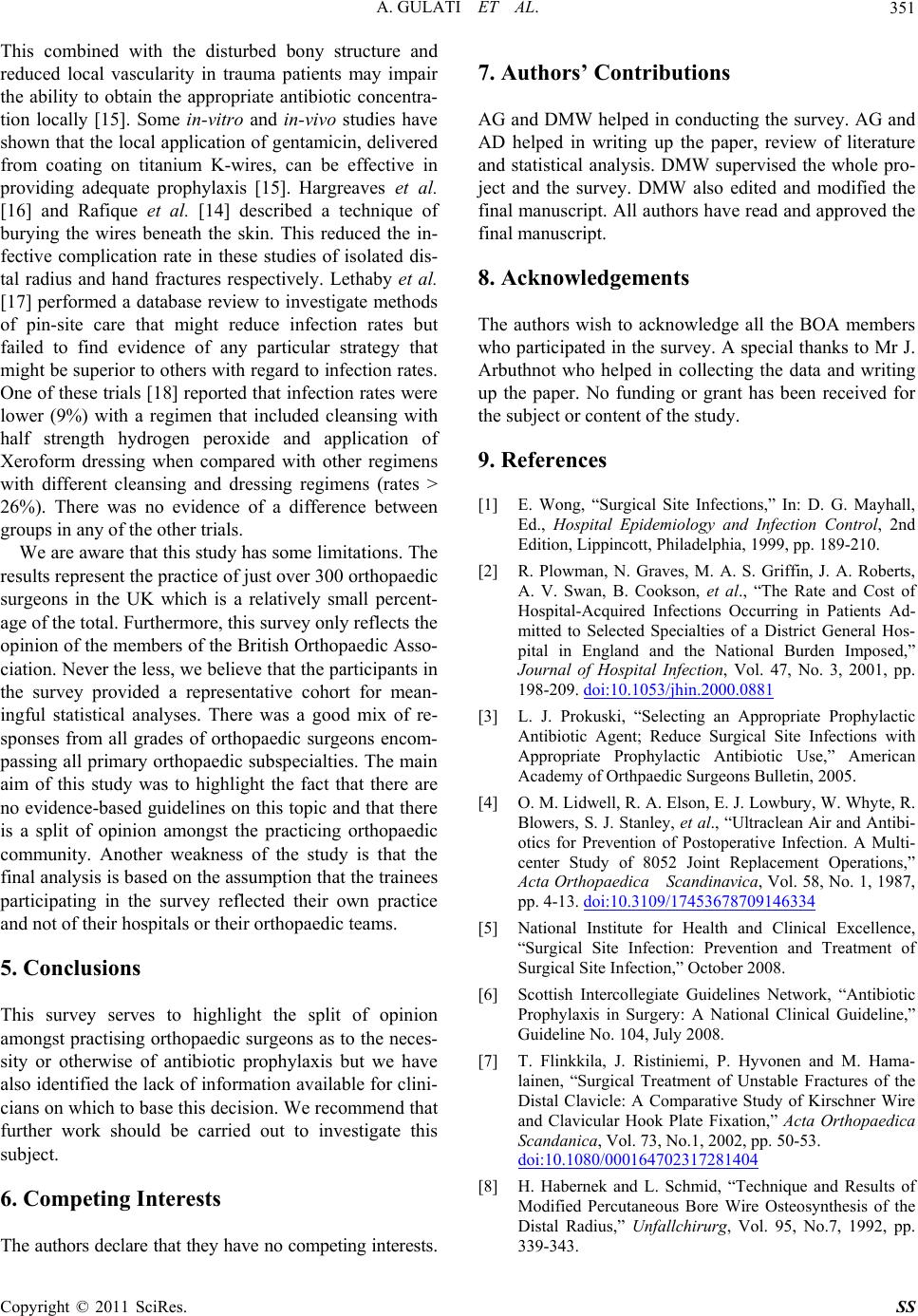
A. GULATI ET AL.351
This combined with the disturbed bony structure and
reduced local vascularity in trauma patients may impair
the ability to obtain the appropriate antibiotic concentra-
tion locally [15]. Some in-vitro and in-vivo studies have
shown that the local application of gentamicin, deliv ered
from coating on titanium K-wires, can be effective in
providing adequate prophylaxis [15]. Hargreaves et al.
[16] and Rafique et al. [14] described a technique of
burying the wires beneath the skin. This reduced the in-
fective complication rate in these studies of isolated dis-
tal radius and hand fractures respectively. Lethaby et al.
[17] performed a database review to investigate methods
of pin-site care that might reduce infection rates but
failed to find evidence of any particular strategy that
might be superior to others with regard to infection rates.
One of these trials [18] reported that infection rates were
lower (9%) with a regimen that included cleansing with
half strength hydrogen peroxide and application of
Xeroform dressing when compared with other regimens
with different cleansing and dressing regimens (rates >
26%). There was no evidence of a difference between
groups in any of the other trials.
We are aware that this study has some limitations. The
results represent the practice of just over 300 orthopaedic
surgeons in the UK which is a relatively small percent-
age of the total. Furthermore, this survey only reflects the
opinion of the members of the British Orthopaed ic Asso-
ciation. Never the less, we believe that the participants in
the survey provided a representative cohort for mean-
ingful statistical analyses. There was a good mix of re-
sponses from all grades of orthopaedic surgeons encom-
passing all primary orthopaedic sub specialties. The main
aim of this study was to highlight the fact that there are
no evidence-b ased guidelines on this topic and that there
is a split of opinion amongst the practicing orthopaedic
community. Another weakness of the study is that the
final analysis is based on the assumption that th e trainees
participating in the survey reflected their own practice
and not of their hospitals or their orthopaedic teams.
5. Conclusions
This survey serves to highlight the split of opinion
amongst practising orthopaedic surgeons as to the neces-
sity or otherwise of antibiotic prophylaxis but we have
also identified the lack of information available for clini-
cians on which to base this decision. We recommend that
further work should be carried out to investigate this
subject.
6. Competing Interests
The authors declare that they have no competing interests.
7. Authors’ Contributions
AG and DMW helped in conducting the survey. AG and
AD helped in writing up the paper, review of literature
and statistical analysis. DMW supervised the whole pro-
ject and the survey. DMW also edited and modified the
final manuscript. All authors have read and approved the
final manuscript.
8. Acknowledgements
The authors wish to acknowledge all the BOA members
who participated in the survey . A special thanks to Mr J.
Arbuthnot who helped in collecting the data and writing
up the paper. No funding or grant has been received for
the subject or content of the study.
9. References
[1] E. Wong, “Surgical Site Infections,” In: D. G. Mayhall,
Ed., Hospital Epidemiology and Infection Control, 2nd
Edition, Lippincott, Philadelphia, 1999, pp. 189-210.
[2] R. Plowman, N. Graves, M. A. S. Griffin, J. A. Roberts,
A. V. Swan, B. Cookson, et al., “The Rate and Cost of
Hospital-Acquired Infections Occurring in Patients Ad-
mitted to Selected Specialties of a District General Hos-
pital in England and the National Burden Imposed,”
Journal of Hospital Infection, Vol. 47, No. 3, 2001, pp.
198-209. doi:10.1053/jhin.2000.0881
[3] L. J. Prokuski, “Selecting an Appropriate Prophylactic
Antibiotic Agent; Reduce Surgical Site Infections with
Appropriate Prophylactic Antibiotic Use,” American
Academy of Orthpaedic Surgeons Bulletin, 2005.
[4] O. M. Lidwell, R. A. Elson, E. J. Lowbury, W. Whyte, R.
Blowers, S. J. Stanley, et al., “Ultraclean Air and Antibi-
otics for Prevention of Postoperative Infection. A Multi-
center Study of 8052 Joint Replacement Operations,”
Acta Orthopaedica Scandinavica, Vol. 58, No. 1, 1987,
pp. 4-13. doi:10.3109/17453678709146334
[5] National Institute for Health and Clinical Excellence,
“Surgical Site Infection: Prevention and Treatment of
Surgical Site Infection,” October 2008.
[6] Scottish Intercollegiate Guidelines Network, “Antibiotic
Prophylaxis in Surgery: A National Clinical Guideline,”
Guideline No. 104, July 2008.
[7] T. Flinkkila, J. Ristiniemi, P. Hyvonen and M. Hama-
lainen, “Surgical Treatment of Unstable Fractures of the
Distal Clavicle: A Comparative Study of Kirschner Wire
and Clavicular Hook Plate Fixation,” Acta Orthopaedica
Scandanica, Vol. 73, No.1, 2002, pp. 50-53.
doi:10.1080/000164702317281404
[8] H. Habernek and L. Schmid, “Technique and Results of
Modified Percutaneous Bore Wire Osteosynthesis of the
Distal Radius,” Unfallchirurg, Vol. 95, No.7, 1992, pp.
339-343.
Copyright © 2011 SciRes. SS